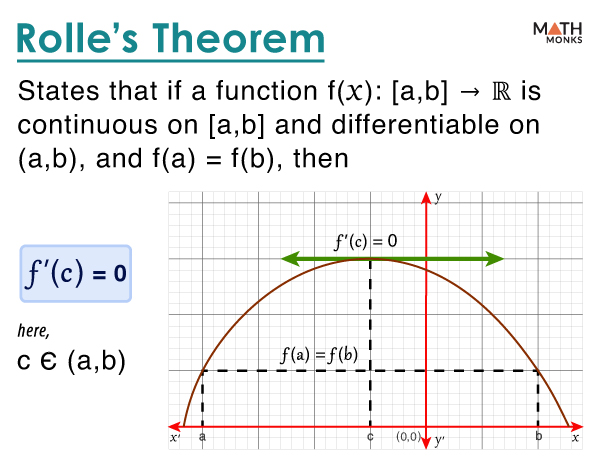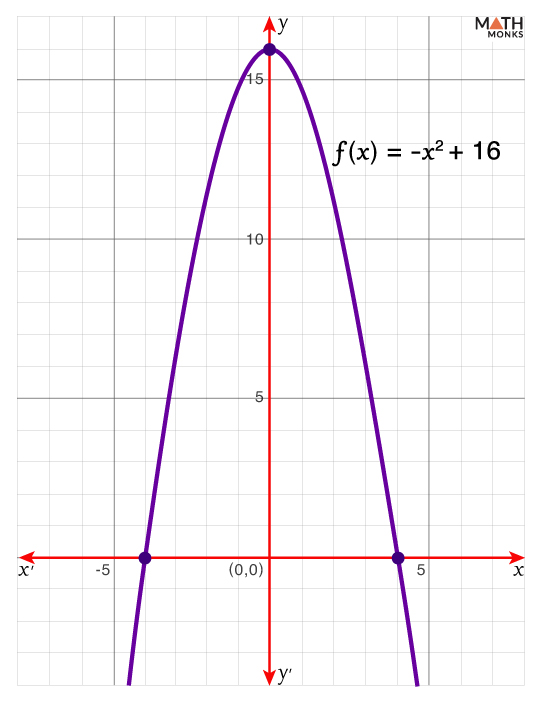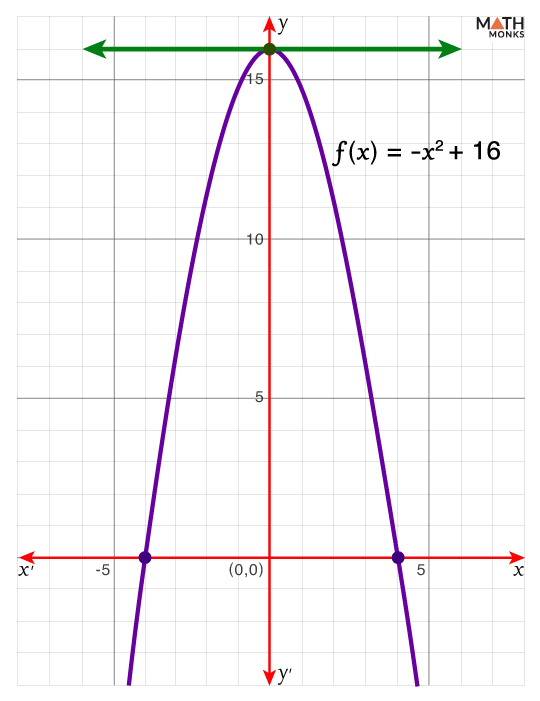Rolle’s theorem is a theorem in calculus that states if a function ‘f’ is continuous on the closed interval [a, b], differentiable on the open interval (a, b), and f(a) = f(b), then there exists at least one point c Є (a, b), such that f’(c) = 0.
Mathematically,
Let f(x): [a, b] → ℝ be continuous on [a, b] and differentiable on (a, b)
If f(a) = f(b), then
f’(c) = 0, where c Є (a, b)
Thus, Rolle’s Theorem states that if a function has 2 points (a, f(a)) and (b, f(b)) on a graph with the same y-coordinate, then there is at least one relative minimum or maximum between these points where the function ‘turns around’ and the first derivative is 0 at that point.
Thus, it is a special case of Lagrange’s mean value theorem (MVT).
Graphing
Let us plot the function f(x) = -x2 + 16 on [-4, 4].
In the above graph, since the curve is smooth on [4, -4] with no breaks or jumps, f(x) is continuous and differentiable within the interval. Also, f(-4) and f(4) cuts the x-axis, which means the two points (-4, f(-4)) and (4, f(4)) have the same y-coordinate.
By Rolle’s theorem, we get at least one relative minimum or maximum between the points (-4, f(-4)) and (4, f(4)) where the function is turning around.
Here, at x = 0 (-4 < 0 < 4), f(x) turns around.
Thus, it is possible to draw a horizontal tangent line at x = 0 and f(0) = 16 where f’(0) = 0.
Proof
Case 1: When ‘f’ is Constant
Since ‘f’ is continuous on [a, b], from the extreme value theorem, ‘f’ attains the maximum and minimum values on [a, b].
Also, since ‘f’ is differentiable on (a, b), f’(c) exists for c Є (a, b). If this occurs at the endpoints ‘a’ and ‘b,’ then f(x) is a constant function on [a, b], and f’(x) = 0 at any point.
Thus, at any point c Є (a, b), f’(c) = 0, Rolle’s theorem holds.
Case 2: When ‘f’ is Not Constant
Now, let us suppose that f(x) is not a constant function on [a, b]. This implies there exists at least one point where f(x) attains a maximum or minimum value on (a, b).
Now, considering f(x) attains its maximum and minimum value at an interior point ‘c’ on (a, b), we get:
Since the derivative is zero or undefined at both maximum and minimum points, then for f(x) attaining its maximum value or minimum value at ‘c,’ f’(c) = 0
Let us suppose that f(x) reaches its maximum and minimum values at an endpoint ‘a’ or ‘b.’ If f(x) attains its maximum value at ‘a’ without any loss of generality and f(a) = f(b), then f(x) attains its maximum value at ‘b.’
Hence, ‘f’ is a constant function on [a, b], and Rolle’s theorem holds.
In either case, we find at least one point ‘c’ on (a, b) such that f’(c) = 0.
Thus, Rolle’s theorem is proved.
Rolle’s theorem can also be proved using Lagrange’s mean value theorem.
Alternative Method
Let the function ‘f’ be differentiable on (a, b) and continuous on [a, b]
If f(a) = f(b)
By Lagrange’s mean value theorem, we get
${f’\left( c\right) =\dfrac{f\left( b\right) -f\left( a\right) }{b-a}}$
⇒ ${f’\left( c\right) =\dfrac{f\left( b\right) -f\left( b\right) }{b-a}}$
⇒ ${f’\left( c\right) =\dfrac{0}{b-a}}$
⇒ ${f’\left( c\right) =0}$
Thus, Rolle’s theorem is proved.
Finding Roots
Let us apply Rolle’s theorem to find the roots of a polynomial function f(x) = x3 – 3x2 + 2x on [0, 2].
Since f(x) is a polynomial function, ‘f’ is continuous and differentiable at any interval, which satisfies the conditions of Rolle’s theorem.
Now, evaluating f(0) and f(2), we get
f(0) = (0)3 – 3(0)2 + 2(0) = 0
f(2) = (2)3 – 3(2)2 + 2(2) = 0
Thus, f(0) = f(2) = 0
By Rolle’s theorem, there exists at least one point c Є (0, 2), f’(c) = 0
Now, we find ‘c’ such that f’(c) = 0
Finding the derivative of f(x), we get
f’(x) = 3x2 – 6x + 2
Putting f’(x) = 0, we get
3x2 – 6x + 2 = 0
Using the quadratic formula, we get
${x=\dfrac{-\left( -6\right) \pm \sqrt{\left( -6\right) ^{2}-4\times 3\times 2}}{2\times 3}}$
⇒ ${x=\dfrac{6\pm \sqrt{12}}{6}}$
⇒ ${x=\dfrac{3\pm \sqrt{3}}{3}}$
Here, x ≈ 1.577 and x ≈ 0.423, and both the roots are within (0, 2)
Thus, By Rolle’s theorem, we get two roots of f(x) = x3 – 3x2 + 2x on [0, 2], specifically at x ≈ 1.577 and x ≈ 0.423
Solved Examples
![]() Verify if Rolle’s theorem satisfies for the function f(x) = |x5 – 3x| on [-1, 1]
Verify if Rolle’s theorem satisfies for the function f(x) = |x5 – 3x| on [-1, 1]
Solution:
![]()
Since f(x) is an absolute value function, f(x) is continuous on [-1, 1]
The function f(x) = |x5 – 3x| is differentiable at all points where x5 – 3x is differentiable.
Since the polynomial x5 – 3x is differentiable everywhere, the absolute value function is differentiable everywhere except at points where its argument is not differentiable.
However, x5 – 3x is differentiable for all x, and f(x) is also differentiable on [-1, 1].
Now, f(-1) = |(-1)5 – 3(-1)| = |-1 + 3| = |2| = 2
f(1) = |(1)5 – 3(1)| = |1 – 3| = |-2| = 2
Since f(-1) = f(1) = 2, the conditions of Rolle’s Theorem are satisfied.
Thus, at least one point ‘c’ exists on (-1, 1) where f’(c) = 0.
Calculating the derivative of f(x), we get
${f’\left( x\right) =\dfrac{d}{dx}\left| x^{5}-3x\right|}$
Considering different cases for the behavior of x5 – 3x, we get:
For x < 0, f(x) = -(x5 – 3x) = 3x – x5
⇒ f′(x) = 3 – 5x4
For x > 0, f(x) = x5 – 3x
⇒ f′(x) = 5x4 – 3
For x = 0, f(x) = |(0)5 – 3(0)| = 0
⇒ f′(0) = 0
Since f′(x) is a polynomial, it is continuous and differentiable everywhere. Hence, it is continuous on [-1, 1] and differentiable on (-1, 1).
Now, verifying if f′(x) = 0 for any x on (-1, 1), we get:
For x < 0, f′(x) = 3 – 5x4 = 0
⇒ 3 = 5x4
⇒ ${x^{4}=\dfrac{3}{5}}$
⇒ ${x=\sqrt[4] {\dfrac{3}{5}}}$
For x > 0, f′(x) = 5x4 – 3 = 0
⇒ 5x4 = 3
⇒ ${x^{4}=\dfrac{3}{5}}$
⇒ ${x=\sqrt[4] {\dfrac{3}{5}}}$
Since both solutions are positive, and ${\sqrt[4] {\dfrac{3}{5}}}$ lies within (-1, 1), Rolle’s Theorem is verified for the function f(x) = |x5 – 3x| on [-1, 1].
![]() Verify if Rolle’s theorem satisfies the function f(x) = x2 – 6x + 5 on [1, 5] and determine the values of x = c such that f’(c) = 0.
Verify if Rolle’s theorem satisfies the function f(x) = x2 – 6x + 5 on [1, 5] and determine the values of x = c such that f’(c) = 0.
Solution:
![]()
Since f(x) is a polynomial function, f(x) is continuous on [1, 5] and differentiable on (1, 5).
Now, f(1) = (1)2 – 6(1) + 5 = 1 – 6 + 5 = 0
f(5) = (5)2 – 6(5) + 5 = 25 – 30 + 5 = 0
Since f(1) = f(5) = 0, the conditions of Rolle’s Theorem are satisfied.
Thus, at least one point ‘c’ exists on (1,5) where f’(c) = 0.
Calculating the derivative of f(x), we get
f’(x) = 2x – 6
Now, verifying if f′(x) = 0 for any x on (1, 5), we get
2x – 6 = 0
⇒ 2x = 6
⇒ x = 3
⇒ f’(3) = 0
Thus, Rolle’s Theorem is verified for f(x) = x2 – 6x + 5 on [1, 5], and f′(3) = 0.
Here, at least one ‘c’ exists on (1, 5) such that f′(c) = 0, and c = 3.



